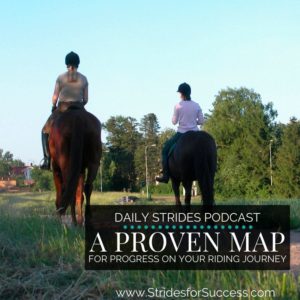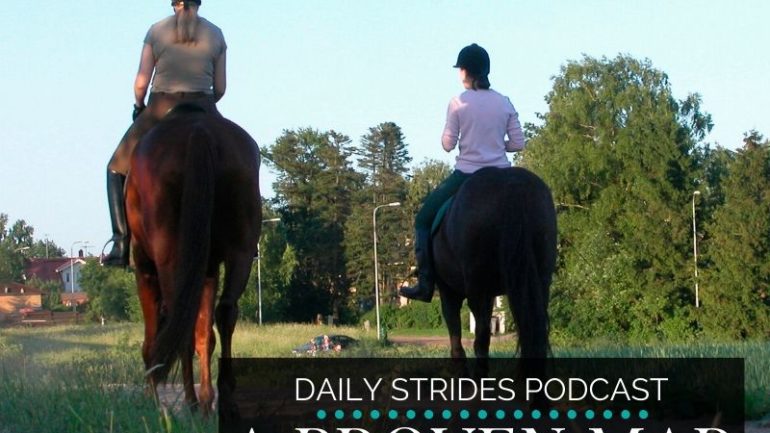
Having a map often simplifies the journey. It helps plan a clear route from A to B. Riding is a journey. And so many riders want a map or a plan to follow for progress in their riding.
Well, hold your horses! What if I was to tell you that there is a map available for equestrians. Oh yes, and it is loosely called the training scale or the traditional training scale. So many riders discount this because they think that they have to be riding at a certain level in order to use it. Or that the training scale is only for riders of a certain discipline, usually dressage.
Many riders also believe that the training scale is only for the horse. And a certain ‘type’ of a horse at that. This couldn’t be further from the truth.
Horse riding is a team sport. Your horse’s long term success depends on your abilities in the saddle. Improve your riding skills and you will have improved conversations with your horse. It is as simple as that.
What is the training scale and how can you use it as a map in your riding?
The training scale is a basic system many trainers use when working with horses. There are certain principles or ‘steps’ which, when followed, ensure that the horse and rider have the mental, emotional and physical ability to progress in their training and riding.
What often happens is that, without even being aware of the training scale, you are working on some of the principles. However, when one piece is ‘missing’ or weak, you’ll find that progress stalls. This is where so many horses and riders then become stuck.
Understanding what the training scale is and how you can begin using it today will help you with this. It means you will clearly see what’s missing or needs work. Which will inevitably lead to fewer gaps in your training. Fewer gaps mean that momentum can really begin working for you where your training and progress are concerned.
By following the principles, step by step, you can really make sure you have a full education in riding. You can also ensure that your horse is being correctly developed, so he will have the physical and mental abilities necessary to progress in his training.
Training Scale Foundation:- Relaxation
Relaxation. It is a big concept for so many riders. And the fact that is has nothing to do with ‘doing nothing’ is what confuses so many! Relaxation should rather be called ‘tension management’. This is what you must do in order to fully understand and implement relaxation. Manage your tension in the saddle.
When you try something new in your riding, often relaxation is the foundational piece that needs attention again. All new principles must be worked through from the perspective of relaxation. Can you manage your tension levels as you move up and down through the gears or gaits? How about if you switch from moving straight to moving laterally? Or if you decide to pop a fence or jump?
Different tension is needed for different tasks or work when riding. Relaxation is your ability to manage your tension, so that it appears smooth throughout the ride.
Training Scale Step 1:- Rhythm
Relaxation is the foundation. This means that rhythm is the first actual ‘step’ on the ladder or scale. Rhythm with horses, in my opinion, is that your horse is as close as possible when being ridden to how he naturally moves, in the field alone.
I believe that your natural rhythm is how you feel when you are ‘doing you’. When you are doing something you love to do that you find easy to do. The thing that makes 3 hours feel like 3 minutes.
The trick is to work on bringing that same feeling across to the saddle with you. That same openness, flow, and energy. Your natural rhythm. This will take time to develop, however it is essential to make progress in your riding.
Training Scale Step 2:- Suppleness
The loosey gooseyness that is essential for both horse and rider. I believe that in most cases where riders are ‘stuck’ are due to a lack of suppleness. This is often seen when the contact is an issue. It is a lack of suppleness from the rider that is causing the block through the horse’s energy.
Suppleness is a mental, emotional and physical development. It is the ability to move and flow, while still remain strong and true.
I am going to ask you to really consider this if you are having issues with, for example, contact with your horse. If it is ‘fleeting’, you have it for a stride or 4 only to lose it again, take a look at your suppleness. Working on this has the potential to really and truly get you unstuck – without having to actually do anything ‘different’ in the saddle.
Training Scale Step 3:- Contact & Connection
Ah, the part everyone wants. The holy grail; ‘on the bit’. However, this cannot be correctly or consistency achieved if the other parts we have mentioned are not strong and active in both horse and rider. I often think of contact as being the step of the training scale where both horse and rider ‘graduate’.
It is where the horse begins to take responsibility for their own actions and way of going. it is also where the rider must be confident enough to allow the horse to do this.
Contact is a little like a contract that both horse and rider are entering into. I am agreeing to trust you if you meet me halfway. This is why sawing, pulling, pushing and shoving will not produce correct contact. The steps we spoke about before are the only way to actually achieving true, lasting contact in the ride.
The Traditional Training Scale – Steps 4 to 6
I have created a free mini-course for you where I go into detail far more detail about the training scale. I really feel that if you can understand these basic principles, it will move your riding forward. Even the most basic of conversations with your horse has these things woven through it.
You can find the 5 Days to Clarity HERE. I hope that you take the 5 to 10 minutes each day to give it a look or listen and really and truly move things forward in your riding.
Happy Riding
Lorna
Other Resources to Help You in Your Riding:-

